Monday 4 May 1942
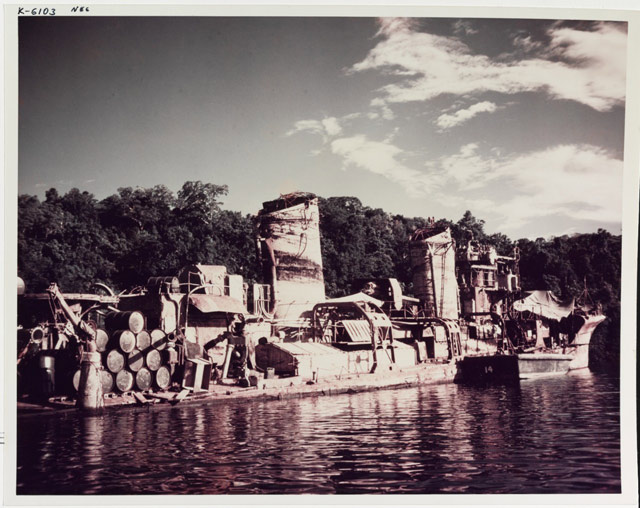 |
| Japanese Destroyer Kikzuki. Beached in Purvis Bay, Florida Island, Solomon Islands, in 1944. She had been sunk on 4 May 1942, when USS Yorktown (CV-5) planes raided the Tulagi area. Salvaged by the U.S. Navy in 1943 (Original color photograph, Naval History and Heritage Command 80-G-K-6103). |
Battle of the Pacific: US Vice Admiral Frank Jack Fletcher, in command of Task Force 17 (led by the aircraft carrier USS Yorktown) and Task Force 11 (USS Lexington), finally is ready to attack on 4 May 1942. Having moved the Yorktown to within about 86 nautical miles (160 km, 99 miles) of Tulagi, he launches his first strike of the campaign at 07:01. It consists of 12 TBD Devastator torpedo bombers and 28 SBD Dauntless dive bombers heading to Tulagi Island, which the Japanese captured on 3 May 1942. The objective is the large fleet of ships anchored near the island under the command of Rear Admiral Kiyohide Shima. This is considered the beginning of the Battle of the Coral Sea.
The Japanese intended to have air cover over the invasion ships, but Admiral Takeo Takagi's aircraft carriers have been trying to ferry fighters to Rabaul but have been prevented from doing so by poor weather. It is unclear if Takagi ever actually completed that minor ferrying job, but he pointlessly has spent two days trying to do it and now his carriers are out of position exactly when they are needed most. Due to the delay, carriers Shokaku and Suikaku are 340 miles north of Tulagi, much too far away to intervene. Takagi has made a huge blunder, of course, but the real fault lies with the overly intricate Japanese operational plan that requires perfect timing of all of its parts without any allowances for outside interference by things that can disrupt that timetable - like the weather.
The US aircraft, facing no real air opposition, begin dropping their bombs on the ships at Tulagi at 08:50. They take the Japanese, who are still unloading troops and have most of their ships at anchor, completely by surprise. They hit two ships, Okinoshima (minor damage) and 1315-ton destroyer Kikuzuki (major damage, 12 deaths and 142 survivors). The Japanese manage to beach the latter ship on nearby Gavutu Island. The attackers also down a Mitsubishi F1M2 "Pete" floatplane that attempts to take off during the raid.
Fletcher is not done yet. After the planes return to Yorktown, he orders them to undertake a second strike. They arrive at 12:10 and sink two 215-ton minesweepers (Wa-1 and Wa-2) and damage another, Tama Maru (four dead, seven wounded). The US pilots also shoot down another seaplane. Four F4F-3/3A Wildcat fighters from Yorktown then arrive and shoot down two more "Pete" floatplanes over Florida island. The Wildcats then strafe destroyer Yūzuki, killing ten crewmen including the captain, and damage several other floatplanes near Gavutu. While attempting to return to Yorktown, two of the Wildcats run out of fuel and crashland on the southern coast of Guadalcanal (rescued by destroyer USS Hammann).
 |
| Douglas SBD Dauntless dive bombers returning to USS Yorktown after an attack on Tulagi, Solomon Islands, 4 May 1942 (US National Archives US Navy photo #80-G-20515) |
Pleased with the results of the day's first two strikes and pleasantly surprised at the absence of Japanese fighter cover, Fletcher sends in a third strike. Many of the Japanese ships have departed the scene, but the planes damage transport Azumasan Maru and the minelayer/transport Okinoshima. One of the TBDs in this strike runs out of fuel, has to ditch in the ocean, and the crew is not found. After this, Fletcher retires to the south. Takagi attempts to find Fletcher's ships, but his planes search east of the Solomons and find nothing.
While Fletcher's planes have scattered the Japanese ships and scored numerous successes, they have not interfered with the Japanese construction of the seaplane base at Tulagi. The air attacks at Tulagi have been a brilliant demonstration of US naval air power, but they have no strategic effect. The Japanese seaplane base is operational on 6 May.
Meanwhile, the Japanese put the main thrust of Operation Mo into motion today. The invasion force of five thousand troops of the South Seas Force and five hundred of the 3rd Kure Special Naval Landing Force bound for Port Moresby leaves Rabaul. Escorted by one light cruiser and six destroyers, they proceed southward toward Jomard Passage. The plan is to sail around the southern tip of Papua New Guinea around midnight on 6-7 May and then head west to Port Moresby.
The Japanese continue pounding the isolated US island fortress of Corregidor in the Philippines. Today, a dive bomber sinks the 950-ton submarine rescue ship USS Pigeon and shore artillery sinks the 950-ton minesweeper Tanager (AM-5). Commanding officer General Wainwright sends a radio message to Douglas MacArthur in Melbourne, Australia warning that, "In my opinion, the enemy is capable of making an assault on Corregidor at any time. Wainwright knows he only has a four-day supply of potable water remaining.
Shortly thereafter, the first Japanese troops, 600 men, land on Corregidor. The 1300 men of the First Marine Battalion begin a defensive struggle that quickly moves to the entrance of Malinta Tunnel. President Roosevelt sends Wainwright a message, "You and your devoted followers have become the symbols of our war aims and the guarantee of our victory."
US Navy submarine USS Greenling (SS-213) torpedoes and sinks 3252-ton Japanese armed merchant cruiser Kinjosan Maru near Truk (Chuuk).
US Navy submarine USS Trout (SS-202) torpedoes and sinks 2119-ton Japanese auxiliary gunboat Kongosan Maru east of Honshū, Japan.
 |
| Major General Lewis H. Brereton is on the cover of the 4 May 1942 Time magazine. He is the commander of the Tenth Air Force with its headquarters in New Delhi, India. |
Battle of the Indian Ocean: Having finally gotten across the Shweli River on the road from Lashio after several days of effort, Japanese troops drive into the regional center of Bhamo. Their next objective is Myitkyina. There is little to stand in their way on the road from Bhamo to Myitkyina except disorganized remnants of lost battles. Chinese troops also give ground on the Burma River.
The British evacuate the island of Akyab (Sittwe), which is prized due to its airfield and deepwater port. This is in part due to a surge in malaria cases that has affected morale. The Japanese advance is now getting uncomfortably close to India.
After dark, four B-17s of 10th Air Force raid Mingaladon Airfield, Rangoon. They damage a hangar and parked aircraft.
At Diego Suarez in Vichy Madagascar, a German crew partially scuttles 6181-ton freighter Wartenfels in its dry dock. The British and Australians will find the ship there when they invade later in 1942. They will repair it and return it to service as Empire Tugela.
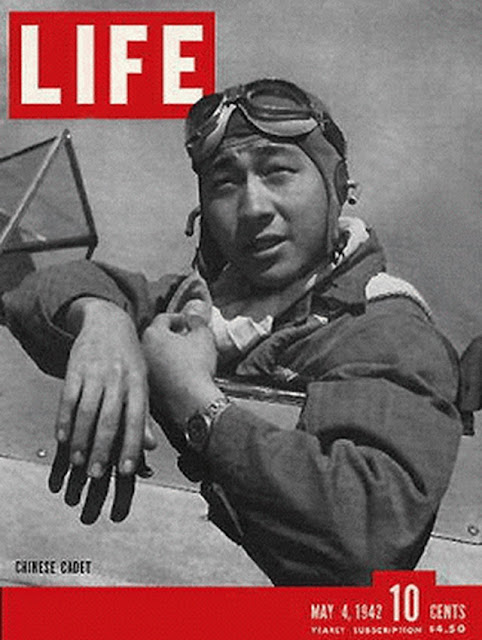 |
| The 4 May 1942 Life magazine features a Chinese air cadet on the cover. |
Eastern Front: While Demyansk has been relieved, the nearby and much smaller garrison at Kholm remains surrounded. General Franz Halder notes in his war diary, "Attack to free Kholm has opened with good results." Halder notes that unlike the past week or two, the Soviets have launched some attacks that "were repelled; more attacks must be expected."
Halder also hints at growing tensions within the high command. He writes that at the daily Fuhrer Conference, there were "At times very lively exchange of views." This generally means that Hitler reacted to something with a screaming fit. Halder continues that "von Kuechler's suggestion to abandon the offensive in South in order to maintain the operation in North, is sharply disapproved." In other words, the Army Group North Commander, General Georg von Kuechler, asks to concentrate power at Leningrad and take it rather than dispersing inadequate effort all along the front. This is a roundabout way of saying that the Wehrmacht is overstretched in Russia, which it is, though nobody can say that to the Fuhrer. Hitler remains determined to make a decisive grab for the oil fields in the South and let the siege at Leningrad continue. Von Kuechler does not fall out of favor over this, as Hitler later promotes him to Field Marshal.
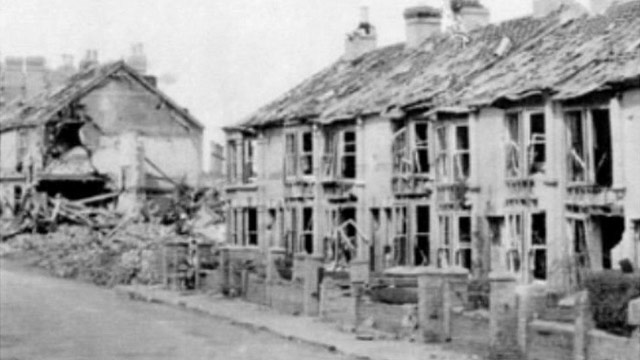 |
| Damage on Arctic Road in West Cowes due to the 4 May 1942 Luftwaffe raid. |
European Air Operations: The Luftwaffe continues its Baedeker Raids with an attack on Cowes and East Cowes, Isle of Wight. This has the large J. Samuel White Shipyard. Bombers drop 200 tons of bombs, beginning with incendiaries followed by high explosives. There are 70 deaths and many damaged buildings in a 100,000 square-foot (10,000 square meters) area of destruction. Polish destroyer Blyskawica, being refitted at the shipyard, puts up a strong anti-aircraft defense (Blyskawica later is preserved and becomes the oldest preserved destroyer in the UK).
During the day, RAF Bomber Command sends six Boston bombers to attack the Le Havre power station. No hits are made on the target and no bombers are lost.
After dark, the RAF's target is Stuttgart. It sends 121 aircraft (69 Wellingtons, 19 Hampdens, 14 Lancasters, 12 Stirlings, 7 Halifaxes) in the first major raid on Stuttgart. One Stirling fails to return. The night is very cloudy and bombing accuracy is poor. The Robert Bosch factory, which makes dynamos, injection pumps, and magnetos, is the primary target, but no hits are made on it. There are 13 deaths and 37 injured and only scattered damage to Stuttgart. A German decoy site at Lauffen 15 miles north of Stuttgart, though, receives a lot of damage. It is lit up by 35 searchlights and has 50 flak guns in action. The decoy site (Nachtscheinanlage) deceives the bomber crews on this and many other missions into thinking it is a major city when in fact it was empty countryside. The British also have used this tactic successfully ("Starfish sites," code-named "Q" sites).
There are minor operations of 9 bombers to Nantes, 6 Stirling bombers to Pilsen, 8 bombers on minelaying missions off Heligoland, and 6 bombers on leaflet flights. One bomber sent to Pilsen fails to return.
 |
| Houses at Sun Hill, Cowes, after the 4 May 1942 Luftwaffe raid (Friends of the O.R.P. Blyskawica Society). |
May 4, 1942, is notable for the first combat mission of the North American Mustang Mk. 1, though only over England. These are Mustangs built to British requirements and are designated NA-73s, not P-51s as they will be in the US Army Air Force. The British Mustangs fly with RAF No. 26 Squadron on a patrol from Gatwick, Surrey. The RAF is unimpressed with the fighter's high-altitude performance - which is considered necessary for an air superiority fighter - and relegates the fighters to Army Co-operation Command rather than Fighter Command. It equips its Mustangs with cameras to fly low-level reconnaissance.
 |
| The cover story of Newsweek magazine, 4 May 1942, is about "Battles in Burma: The Chinese Fight for Their Lifeline." |
Battle of the Atlantic: After two days of losses by both sides in the Barents Sea, the weather takes a turn for the worse and decides matters. It degenerates from Arctic gales into a full-blown snowstorm and hostilities must cease. Both PQ 15 and QP 11 escape further damage, with the former having lost three freighters and a destroyer (the Punjabi, with HMS King George V damaged after colliding with it) and the latter one freighter, a submarine, and escorting cruiser HMS Edinburgh. PQ 15 arrives in Murmansk on 5 May and QP 11 arrives in Iceland on 7 May.
The Allies consider both convoys to have been a success despite the losses, particularly since PQ 15 is the largest Arctic Convoy (22 ships make port at Murmansk) so far. The Germans, too, are delighted, as they have created havoc on the Arctic convoy route at the expense of only three Heinkel torpedo bombers and one destroyer lost. The stage now is set for even larger convoy battles in the future.
U-162 (FrgKpt. Jürgen Wattenberg), on its second patrol out of Lorient, torpedoes and sinks 3785-ton US freighter Eastern Sword 12 nautical miles (22 km) off the Georgetown Lighthouse, British Guiana (Guyana). There are 16 deaths and 13 survivors, who make landfall in their lifeboat aside from one man picked up by local fishing boat Ocean Star.
U-162 also surfaces and shells 119-ton British three-masted schooner Florence M. Douglas off the coast of Guyana. Everyone survives.
 |
| Detroit, Michigan, conducts a blackout drill on 4 May 1942. Detroit is the location of critical industries necessary for the war effort. |
U-564 (Kptlt. Reinhard Suhren), on its fifth patrol out of Brest, torpedoes and sinks 9767-ton British tanker Eclipse, a member of Convoy ON-87, near Fort Lauderdale, Florida. There are two deaths and 45 survivors. The ship sinks in very shallow water and is later salvaged, repaired, and returned to service in December 1942.
U-507 (KrvKpt. Harro Schacht), on its second patrol out of Lorient, torpedoes and sinks 2686-ton US Design 1074 tanker Norlindo 80 nautical miles (150 km) northwest of Dry Tortugas Island. There are five deaths and 28 survivors, rescued by Panamanian freighter San Blas.
U-507 later torpedoes and then surfaces to shell and sink 5104-ton tanker Munger T. Ball. The ship erupts in flames due to the 65,000 barrels of gasoline on board. There are 30 deaths and only four survivors, rescued by Norwegian freighter Katy. This sinking is sometimes listed as occurring on 5 May.
U-507 finds a third US tanker, 6950-ton Joseph M. Cudahy, and torpedoes and sinks it about 74 miles northwest of the Dry Tortugas. There are 27 deaths and 10 survivors. This sinking is sometimes listed as occurring on 5 May.
 |
| HMS Rodney at Liverpool, 4 May 1942 (© IWM A 9608). |
U-125 (Kptlt. Ulrich Folkers), on its fourth mission out of Lorient, torpedoes and sinks 5687-ton US freighter Tuscaloosa City 200 miles west of Negrit, Jamaica. All 34 men on board survive, picked up by US freighter Falcon. The U-boat captain surfaces after the attack, questions the crew, gives them directions to shore and wishes them well.
British 7037-ton freighter Empire Story runs aground in foul weather at Briar Island, Nova Scotia. The crew abandons the ship, but it later works itself off the island itself and is found and taken in tow by Canadian tug Foundation Franklin. On the way to Digby, Empire Story capsizes and sinks.
RAF bombers of Coastal Command sink 2936-ton German freighter Klaus Fritzen at Måløy, near Bergen, Norway.
RAF bombers of Coastal Command also sink 4647-ton German freighter Sizilien off Borkum, Germany. During these Coastal Command raids, a flak ship 20 km southwest of Egmond aan Zee shoots down an RAF Hudson V AM530. All five crewmen perish.
German 773-ton freighter Herrenwyk (formerly Finnish Martti-Ragnar, captured at Bergen) hits a mine and sinks in the Bay of Kiel, Germany.
A 9-ton British fishing boat, FV Little Express, hits a mine in the Thames Estuary and is destroyed. All three men aboard perish.
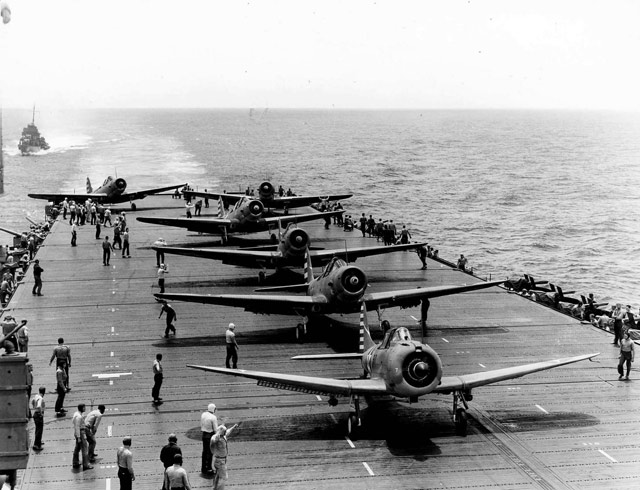 |
| An SBD Dauntless scout-bomber and five TBD-1 Devastator torpedo planes prepare to take off from the USS Enterprise during operations in the south Pacific area, 4 May 1942 (US Navy). |
Battle of the Mediterranean: At Malta, a Luftwaffe fighter downs the Spitfire of Flight Lieutenant Norman MacQueen. MacQueen had just been announced as a winner of the Distinguished Flying Cross in the London Gazette on 1 May 1942. Malta Command also activates a new Infantry Brigade today, the Western Infantry Brigade, bringing the total to four. Luftwaffe raids begin at 10:25 and continue throughout the day.
Battle of the Black Sea: Luftwaffe aircraft sink 836-ton Russian transport Potemkin en route from Kamysh, Crimea - Burun, Turkey. There are 30 deaths and 25 wounded. This sinking is sometimes listed as occurring on 5 May.
Special Operations: The British Special Operations Executive (SOE) team Norwegian Independent Company 1 performs a successful sabotage operation against the electric railway Thamshavn Line in Orkdal, Norway. The objective is to prevent the Third Reich from transporting the pyrites that are being extracted at the mine at Løkken Verk. This is the first in a series of raids to accomplish this objective which, due to concerns of local residents, is done by targeted sabotage rather than RAF bombing.
Three men from Company Linge, having sailed from the UK via fishing boat, alight at Bjørnør on Fosen and travel overland to Namdalseid. A German lorry helpfully gives them a lift for part of the way. At Orkdal, they target the transformer station for the railway at Bårdshaug. The explosion at 05:00 wrecks the station and brings all traffic on the electric railway to a standstill. The three saboteurs escape to Sweden via Trondheim.
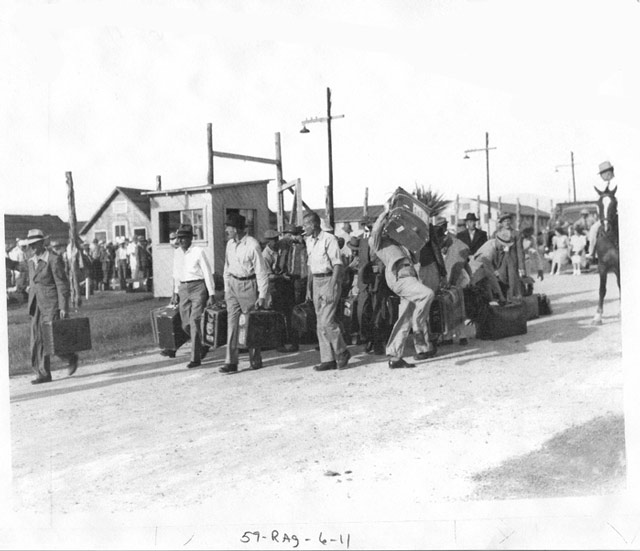 |
| German internees at Camp Kenedy, Texas, 1942 (German American Internee Coalition). |
Hungarian/Uruguayan Relations: Hungary severs relations with Uruguay. This apparently is retaliation for Uruguay breaking diplomatic relations with Germany, Italy, and Japan on 25 January 1942. Uruguay is not at war with any of the Axis powers, however (not until 21 February 1945, when it declares war on Germany and Japan). Uruguay has a large ethnic German population and is important for the Battle of the Atlantic because of the port of Montevideo, the last stop for Kriegsmarine heavy cruiser Admiral Graf Spee. Latin America is under heavy diplomatic pressure from Washington to favor the Allies, of course.
US Military: The Commander in Chief U.S. Fleet, Admiral Ernest J. King, directs the Coast Guard Auxiliary to organize civilian small craft as coastal picket ships.
Danish Homefront: Vilhelm Buhl becomes the 11th Prime Minister of Denmark, replacing the recently deceased Thorvald Stauning. He leads the unity government created by Stauning. The Third Reich at this time is allowing Denmark a very small degree of political independence, though that is entirely subject to Adolf Hitler's whims and is more of an illusion than a reality.
American Homefront: Albert Greutert, Acting Swiss Consul and representing Italian and German interests, and F. van den Arend, Special Division, Department of State, submit separate reports on conditions at detention camps Camp Kenedy and the Doud Field Alien Internment Camp at Fort Sam Houston in San Antonio, Texas. Greutert's report notes that Camp Kenedy, "made up of pre-fabricated barracks," is "not fully organized yet" and "was hardly prepared for the influx of about 500 German internees." There also are about 160 Japanese internees there. The report continues, "I found the conditions [at Fort Sam Houston] in every regard so much better than those prevailing at the Kenedy camp, with everything nice and running smoothly." Greutert notes that the Camp Kenedy inmates have broken up into "several very different groups, especially with regard to their former countries of residence."
The US Office of Price Administration issues Ration Book Number One to every American to use when purchasing rationed items, including sugar, coffee, and meat.
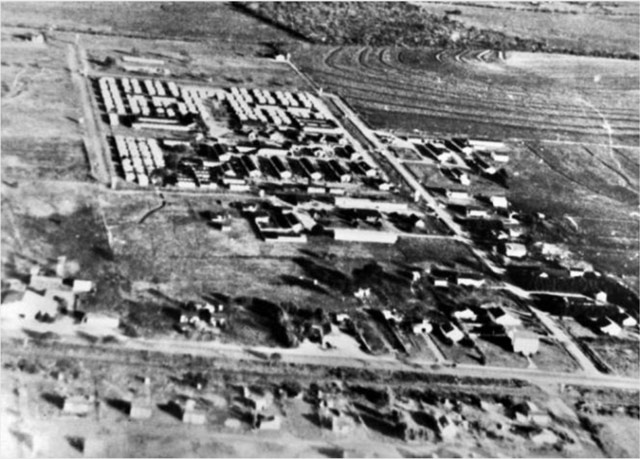 |
| Camp Kenedy Internment Camp, 1942, a former Civilian Conservation Corps (CCC) camp near the town of Kenedy, Texas (German American Internee Coalition). |

No comments:
Post a Comment